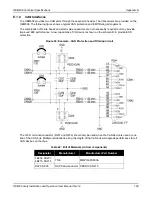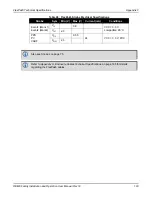
OEM638 Technical Specifications
Appendix E
OEM6 Family Installation and Operation User Manual Rev 12
188
The OEM638 Ethernet LED control lines may sink current directly from an LED (with an appropriate current-
limiting resistor). The 3.3 V supply used to bias the Ethernet magnetics must not be used to drive the LEDs.
The LED drive pins are 3.3 V tolerant only.
The following table gives recommended Ethernet transformer characteristics:
Table 44: Recommended Ethernet Transformer Characteristics
Table 45:
Bill of Materials (Critical Components Only)
E.1.9
System Performance
The OEM638 receiver (as with any precision GNSS product) is an extremely sensitive radio receiver.
Typical GNSS signal levels are on the order of -145 dBm. Spurious emissions from digital logic (especially a
microprocessor) or a nearby radio transmitter can easily meet the appropriate EU or FCC emission limits and
still have emissions several orders of magnitude above the level of the GNSS carrier.
These emissions may desensitize the GNSS receiver and lead to performance degradation (low carrier to
noise ratios, position accuracy or loss of lock in extreme cases).
There are two bands of interest:
•
Low Band (1165 MHz to 1300 MHz)
: contains Galileo E5A, GPS L5, Galileo E5B, BeiDou B2, GPS
L2 and GLONASS L2.
•
High Band (1525 MHz to 1613 MHz)
: contains TerraStar, BeiDou B1,Galileo E1, GPS L1 and
GLONASS L1
Parameter
Value
Test Condition
Turns Ratio
1 CT : 1 CT ±3%
Open-cct Inductance (min)
350 uH
100 mV, 100 kHz, 8 mA
Insertion Loss (max)
1.0 dB (max)
1 - 100 MHz
Return Loss (min)
-18 dB (min)
1 - 10 MHz
-16 dB (min)
10 - 30 MHz
-12 dB (min)
30 - 60 MHz
-10 dB (min)
60 - 80 MHz
Common-Mode Rejection
-30 dB (min)
1 - 100 MHz
Crosstalk
-30 dB (min)
1 – 100 MHz
HIPOT (min)
1500 Vrms
For 1 minute
Designator
Manufacturer
Manufacturer Part Number
J403
Wurth Elektronik
Midcom
7499211121A
7499211121
D405, D406
On Semi
ESD7L5.0DT5G
FB403
MuRata
BLM18PG121SN1D
















































